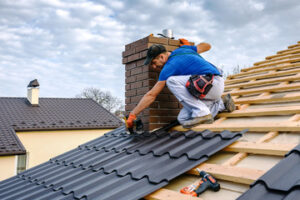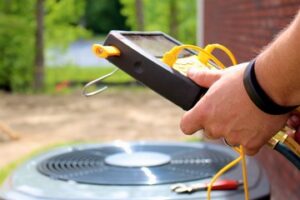Roofing maintenance is vital for the longevity of your roof. There are many tasks that can be performed by building staff to ensure the health of your roof.
A regular survey of the roof field membrane should be undertaken to check for physical damage and environmental deterioration. These surveys can be performed by qualified building mechanics. Visit http://fivestarroofingandcontracting.com/ to learn more.

Gutters play an essential role in directing water off the roof and away from the home. It’s crucial that they remain free from debris and in working condition, or you may face costly water damage. Incorporating gutter cleaning into your roofing maintenance routine can extend the lifespan of your roof and save you from costly repairs down the road.
Gutters are prone to becoming clogged with leaves, pine needles, twigs and more. During heavy rains and humidity, these items can pile up quickly and create blockages. These clogs can overflow and cause water damage to the soffit, fascia, and roof shingles. In addition, standing water can encourage the growth of moss and other plants that can damage or even destroy your roof.
A clogged gutter can also affect the ventilation of your roof. Without proper circulation, excess moisture can lead to mold and mildew, which can deteriorate your shingles and shorten their life. This is why it’s important to clean your gutters regularly, especially after a storm.
Regular gutter cleaning can also prevent ice dams in the winter. These are caused when the melting snow can’t drain off the roof, and it re-freezes as it thaws. This backs up the shingles and leads to leaks and roof rot. It is recommended to have your gutters cleaned at least twice per year, once in the spring and again in the fall.
If you are unsure how to clean your gutters, or if you need help with roof maintenance, Rapid Roofing is happy to assist! Our team of roofing professionals can inspect your home, trim any overhanging branches, and clean your gutters to prevent water damage. Call us today to schedule a cleaning and inspection!
Your roof is one of the most important components of your home, and it needs to be maintained properly. Incorporating regular gutter cleaning and a roof inspection into your annual maintenance plan can help protect your investment and extend the life of your roof. Contact Rapid Roofing today to schedule your gutter cleaning and inspection! We serve homeowners in Michigan and Ohio.
Check the Soffit and Fascia for Damage
Soffit and fascia are vital components of a roof system that help protect against water damage, insect infestation, and other issues. They’re also important in keeping your home looking polished and finished, as clean and well-maintained fascia and soffit provide a smooth, finished appearance to the roofline.
As the name suggests, soffits are located under the overhang of your roofline. They’re designed with vents that allow for proper attic ventilation, allowing air to flow freely and preventing excess moisture in the attic. In turn, this helps regulate the temperature in the attic and prevents mold and mildew, as well as ice dams in winter.
Fascia, on the other hand, is a board that holds gutters and can be found running horizontally along the edge of your roof. It’s primarily designed to provide protection against the elements and pests, as it prevents the edge of your roof from coming into contact with the elements, and helps safeguard the space from rotting and other damage. Fascia is also useful for helping keep pests like birds, squirrels, and insects from nesting in your attic.
Because soffit and fascia are so critical to your roof’s integrity, it’s imperative that you regularly inspect them for damage or deterioration. If you find signs of damage, such as peeling paint or discoloration, cracks, or holes, it’s time to have them inspected and repaired by a professional.
One of the most common issues that affects soffits and fascia is moisture damage. If these structures are exposed to excessive moisture, they’ll rot and eventually break down, which can cause severe problems for your roof. Regular inspections can catch the damage before it becomes a problem, and prompt repairs can avoid costly damages.
Another sign that your soffit and fascia are in need of repair is the presence of mold or mildew. If you notice any of these growing on your fascia and soffit, it’s likely because they are poorly ventilated, allowing moisture to build up in the attic. This can lead to further damage to the roof and attic, so it’s important to get the problem addressed as soon as you notice it.
Trim Branches and Vegetation
As a preventative measure, it is essential to trim branches and vegetation that are close to the roof. Branches that hang over or touch the roof can scrape the surface and cause damage during storms and high winds.
Branches that rub against the roof can also remove protective granules from asphalt shingles, which increases the risk of shingle degradation and exposes the underlying roofing material to the elements. Regular pruning minimizes this problem by maintaining a clearance of 6-10 feet between the roof and tree branches.
Debris accumulation from low-hanging foliage restricts drainage and accelerates membrane deterioration. It also encourages the growth of moss and algae, which can clog gutters and lead to water intrusion in the attic and home. Regular maintenance includes regular surveys of all areas surrounding the roof, including drains, scuppers and gutters to ensure that debris is removed as it accumulates.
Trimming trees regularly can help reduce the likelihood of branches falling on the roof during a storm. Proper trimming techniques can also minimize the risk of cutting too close to the trunk and exposing the tree to disease or pest infestation.
In addition to enhancing curb appeal and property value, regular yard maintenance can prevent pests and rodents from accessing the home through overhanging trees and branches. This may also reduce the need for costly exterminations. Regular pruning of shrubs and hedges can also reduce the amount of debris that collects in attics, clogs gutters and creates a fire hazard. Additionally, the proper placement and timing of trees and shrubs can significantly improve a property’s overall stability by reducing soil movement and decreasing the impact of wind on structures like roofing materials and home foundations.
Schedule a Roof Inspection
In addition to catching any major issues, such as missing shingles or deteriorating flashing that could lead to roof leaks and structural damage, regular inspections also help homeowners plan and schedule maintenance tasks, extending the lifespan of their roofing system and saving them money in the long run. Furthermore, many insurance policies and roof warranties require a documented history of inspections in order to maintain coverage or validity.
A professional inspector will assess the condition of your roof, taking into account the age of the structure and any existing problems or damage. They will examine the roof surface, including the shingles, tiles, and flashing, as well as the gutters and downspouts, checking for clogs or water damage, and will look at the surrounding trees and shrubbery to ensure they are not overhanging or causing any problems. The inspector will also check the attic and crawlspace for any signs of water damage, such as stains on the ceiling or walls, mold or rot, as well as assessing the attic insulation and ventilation. They will also use a moisture meter to test the level of humidity in the attic, which may indicate any potential problems.
The inspector will provide a detailed report of their findings, with photographs and descriptions of any issues identified. They will also recommend any required repairs or maintenance to be carried out.
If you are considering selling your home, having a regularly scheduled inspection is an excellent way to keep up the value of your property and demonstrate that you have taken a proactive approach to home maintenance. Furthermore, addressing any issues that an inspector might identify before they become significant problems can prevent costly repair bills and allow you to sell your home with peace of mind.
While you can perform some basic roofing maintenance on your own, it is always advisable to have a professional inspect your roof at least once every two years. This will ensure that the integrity of your roof is maintained, catch any minor problems before they escalate into expensive repairs, and save you money in the long run.
